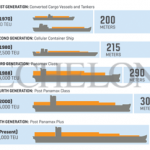Sri Lanka could be ready to receive the largest container vessels somewhere over the next three years, when the first of the three berths at the new Colombo South Port is commissioned. Sri Lanka has been criticised for not capitalizing on its geographic location in the Indian Ocean, which sees about 50 percent of international trade pass though. Currently, it is estimated that the Colombo Port handles about 15 percent of the transshipment business from South Asia.
India meanwhile has invested heavily in expanding its ship handling capacity across most of its key ports, which have in turn contracted with major shipping lines. The involvement of China in Sri Lanka’s port development and also the fact that the contract for the first berth was given to China Merchants Holdings (International) Company Ltd., could better favour the country’s shipping prospects and plans to be a regional hub, because much of the Indian Ocean shipping traffic serves China.
The total capacity of the Colombo Port when the four berths in the South harbour project are completed. Currently, Colombo has a capacity of 4 million TEUs or twenty foot equivalent units.
18,000 TEUs
By 2020 shipbuilders will be casting out bigger container ships that can carry 18,000 – 20 foot containers. Back to back global downturns and the increasing demand to keep prices low has made the shipping business a low margin business, pushing shipping lines to opt for larger vessels to maximize profits by volume.
50
The number of container ships that had a carrying capacity of over 12,500 TEUs by May 2011. The bulk (over seven million) of the current global container fleet comprises of ships that can carry between 3000 and 8000 TEUs.
Image Courtesy: We Are Designers


